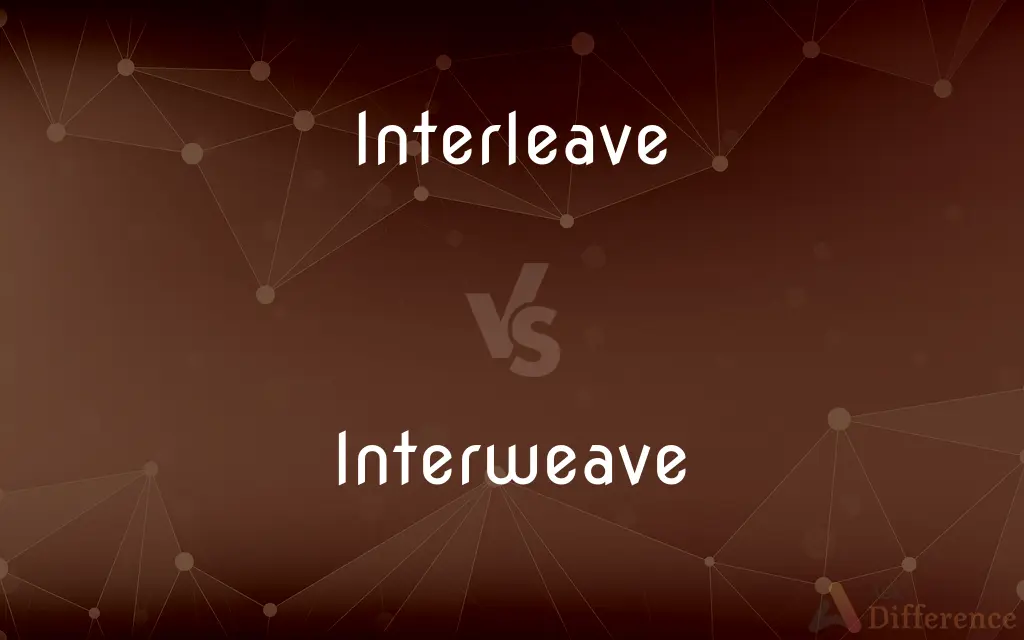Interleave vs. Interweave — What's the Difference?
By Tayyaba Rehman & Maham Liaqat — Updated on April 24, 2024
Interleave involves inserting layers of material between others, often for separation or organization, whereas interweave means to mix or blend by weaving components together.

Difference Between Interleave and Interweave
Table of Contents
ADVERTISEMENT
Key Differences
Interleave generally refers to the action of inserting something between the layers of another material. It often pertains to the physical arrangement of pages, sheets, or other elements to create order or enhance readability. On the other hand, interweave implies a more intricate process of mixing or entwining materials or elements, often used metaphorically to describe the blending of ideas, narratives, or components in a complex manner.
While interleaving is a technique widely used in bookbinding, photography, and data organization to separate and protect against damage or interference, interweaving is fundamental in textile and narrative crafting, where elements are physically or thematically woven together to create a unified structure.
Interleave can also be used in computing and data storage to describe the method of arranging data in non-contiguous segments to increase processing speed. On the other hand, interweave doesn't typically apply to the digital realm but remains rooted in the physical and metaphorical blending of elements.
Interleaving is typically a methodical, organized process where the added layers are meant to remain distinct, helping in identification or separation. Conversely, interweaving creates a new, integrated whole where the original components are no longer separately identifiable.
In the context of methodology, to interleave means to systematically alternate layers or sections to prevent confusion or mix-ups. Whereas, to interweave suggests a more creative or complex merging, often requiring skill to blend the elements smoothly and effectively.
ADVERTISEMENT
Comparison Chart
Definition
Inserting layers between others
Weaving elements together
Usage Context
Bookbinding, photography, data storage
Textile, narratives, art
Outcome
Layers remain distinct
Components merge into a new whole
Method
Systematic, organizational
Creative, complex
Metaphorical Use
Less common, more structured
Common, denotes complexity and integration
Compare with Definitions
Interleave
To integrate periodic intervals in a sequence.
The teacher interleaves grammar lessons with vocabulary sessions.
Interweave
To incorporate different elements smoothly and cohesively.
The teacher interweaves humor with lessons to keep the class engaging.
Interleave
In computing, to arrange data non-sequentially to increase performance.
Modern SSDs use interleaving techniques to speed up data access.
Interweave
To blend themes or characters intricately.
The novel interweaves multiple narratives into a single, cohesive plot.
Interleave
To insert pages between the pages of a book.
The artist interleaves colored sheets between the sketches to prevent smudging.
Interweave
To weave together different strands or elements.
The storyteller interweaves myths and historical facts.
Interleave
To organize or separate with interleaved materials.
Archivists interleave old documents with acid-free paper.
Interweave
In textile, to form by intertwining yarns or threads.
Artisans interweave silk and wool to create unique fabrics.
Interleave
To alternate layers of different materials.
Manufacturers interleave carbon fiber and aluminum for enhanced durability.
Interweave
To mix or combine elements into a complex whole.
The film interweaves visual effects and storytelling.
Interleave
To provide with interleaves or an interleaf.
Interweave
To weave together.
Interleave
(transitive) To insert (pages, which are normally blank) between the pages of a book.
Interweave
To blend together; intermix.
Interleave
(transitive) To intersperse (something) at regular intervals between the parts of a thing or between items in a group.
Interweave
To intertwine.
Interleave
To allocate (things such as successive segments of memory) to different tasks.
Interweave
(transitive) To combine through weaving.
Interleave
An interleaved or interspersed arrangement.
The interleave of sectors on a floppy disk
Interweave
(intransitive) To intermingle.
Interleave
To insert a leaf or leaves in; to bind with blank leaves inserted between the others; as, to interleave a book.
Interweave
To weave together; to intermix or unite in texture or construction; to intertwine; as, threads of silk and cotton interwoven.
Under the hospitable covert nighOf trees thick interwoven.
Interleave
To insert something alternately between the parts of; as, to interleave transparencies with the corresponding pages.
Interweave
To intermingle; to unite intimately; to connect closely; as, to interweave truth with falsehood.
Words interwove with sighs found out their way.
Interleave
Provide (books) with blank leaves
Interweave
Interlace by or as it by weaving
Interleave
Intersperse the sectors on the concentric magnetic circular patterns written on a computer disk surface to guide the storing and recording of data
Interleave
Intersperse alternately, as of protective covers for book illustrations
Common Curiosities
Can interweave be used to describe digital processes?
Interweave is typically not used for digital processes; it's more commonly related to physical or metaphorical blending.
Is interleaving effective in data storage?
Yes, interleaving can significantly enhance performance in data storage systems by optimizing access and read/write speeds.
What is interleaving used for in bookbinding?
In bookbinding, interleaving is used to protect illustrations or important text from transferring ink or getting damaged by placing a protective layer between pages.
How does interweaving contribute to storytelling?
Interweaving enriches storytelling by combining various narrative elements, themes, or timelines into a complex and engaging plot.
Which technique would be used in a mixed-media art project?
Interweaving would likely be used in a mixed-media art project to combine various materials and elements into an integrated artwork.
Can interleaving be applied to learning strategies?
Yes, interleaving can be applied to learning strategies, where different subjects or topics are alternated to improve retention and understanding.
What skills are necessary for interweaving effectively?
Skills such as creativity, attention to detail, and an understanding of how different elements can combine and complement each other are vital for effective interweaving.
What is a common metaphorical use of interleave?
A common metaphorical use of interleave could be in organizational strategies where tasks or information are systematically spaced out.
What is the main difference between interleave and interweave in terms of outcome?
The main difference is that interleaving keeps layers distinct and separate, while interweaving merges them into a cohesive whole.
Can interweaving be considered a form of art?
Yes, interweaving is often considered a form of art, especially in textiles and narrative crafting.
Does interweave have applications outside of textiles?
Yes, interweave is also used metaphorically in arts and storytelling to describe the blending of various narrative elements.
Which technique is more systematic, interleaving or interweaving?
Interleaving is more systematic and structured, typically used for organizational purposes.
What materials can be interleaved in construction?
Materials like layers of insulation, reflective films, and other barrier materials can be interleaved in construction to enhance performance.
How do interleaving and interweaving differ in methodology?
Interleaving is about alternating or inserting distinct layers, while interweaving involves blending elements into an integrated whole.
Is interweaving more complex than interleaving?
Yes, interweaving generally involves a more complex process of integration compared to the more straightforward method of interleaving.
Share Your Discovery

Previous Comparison
Analog vs. Discrete
Next Comparison
Fast vs. QuicklyAuthor Spotlight
Written by
Tayyaba RehmanTayyaba Rehman is a distinguished writer, currently serving as a primary contributor to askdifference.com. As a researcher in semantics and etymology, Tayyaba's passion for the complexity of languages and their distinctions has found a perfect home on the platform. Tayyaba delves into the intricacies of language, distinguishing between commonly confused words and phrases, thereby providing clarity for readers worldwide.
Co-written by
Maham Liaqat













































